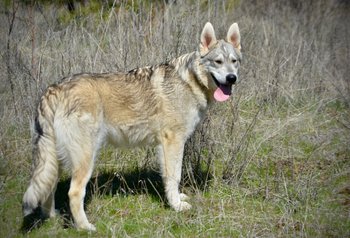Can a dog breed have double muscling and be healthy?
By Jennifer Stoeckl, MAT - Dire Wolf Project CEO, Jan. 28, 2025
Last Friday, I received a pretty awesome question from one of our Dire Wolf Project Inner Circle email subscribers that has been paying attention.
I love getting questions like this one. It awakens the science nerd in me!
Here’s what he asked:
“Happy Friday.
OK so once again I have been stumped by something in your newsletter. I looked up double muscling and found it to be present in Whippets(?) What is it exactly? How does it ultimately affect our breed? How did it get into your dogs?
Sorry to be a PITA, but in my quick look I didn’t get the answers I was looking for!
Mazel Tov on your future litters. They all sound very interesting.
I hope you have a terrific weekend.
As always, regards to Jay.”
Great question, right?
Maybe you also wondered about what is meant by double muscling.
And, trust me, you’re not the first to scratch your head over it!
It’s time to untangle this fascinating topic because—spoiler alert—not all muscle genes are created equal, and the Dire Wolf Project’s approach to breeding couldn’t be more different from what you might have read about in Whippets.
So, grab a cup of tea (or coffee, no judgment here), and let’s dive in.
What Is “Double Muscling”?
When people hear "double muscling," their minds often go straight to the Bully Whippet—a dog that looks like it’s been hitting the gym six days a week and meal-prepping like a pro.
But here’s the deal…
That bulky appearance comes from a Myostatin Mutation—a genetic glitch that turns off the brakes on muscle growth.
Sounds cool, right?
Until you realize there’s a catch.
Actually, several catches.
Bully Whippet Syndrome, as it’s often called, is no walk in the park.
These dogs might look powerful, but their internal organs stay normal-sized while their bodies bulk up.
This mismatch puts an enormous strain on their hearts and lungs, leading to possible health problems like:
- Cardiac issues (the heart just can’t keep up).
- Pulmonary strain (breathing can be tough).
- Shorter lifespans (early wear and tear takes a toll).
It’s a lot for any dog to handle, which is why Bully Whippet Syndrome is considered a serious health condition, not an advantage.
So, what About the American Dirus dog?
Here’s where things get interesting.
The American Dirus does have heavy muscling,
but it’s not caused by the same myostatin mutation.
Instead, the muscle development in our dogs comes from a completely different gene—ACSL4.
This gene creates a natural, balanced build that supports the breed’s thick-boned structure, much like we believe the prehistoric dire wolf had.
Think of it like this:
If the Bully Whippet is the bodybuilder who skipped leg day and overdid it on protein shakes,
The American Dirus is the athlete with a balanced training plan and a diet tailored for long-term health.
Every part of the American Dirus is in harmony—muscles, bones, and internal organs work together perfectly.
Why does heavy muscling matter?
One of the coolest things about dire wolves (and what we’re recreating in the American Dirus) is their incredible bulk.
Fossil evidence shows that dire wolves had thick, dense bones, and to support that weight, they needed some serious muscle power.
Picture a dire wolf standing 30-32 inches tall at the shoulder and weighing over 150 pounds.
That’s a lot of animal!
Without the right musculature to hold up its frame, it wouldn’t have lasted a week in the Ice Age, let alone tens of thousands of years.
The American Dirus dog mirrors this concept.
Its heavy muscling isn’t about show—it’s about function.
The breed’s balanced, natural bulk gives it strength, stability, and durability, while still being a healthy and loving companion in a modern home.
Here’s the bottom line…
The Dire Wolf Project is NOT about chasing extreme looks.
While we want the American Dirus to resemble the majestic dire wolf, health and longevity always come first.
Dogs with Bully Whippet Syndrome might look impressive, but the health risks just aren’t worth it.
We believe in creating dogs that are as strong on the inside as they are on the outside.
That’s why our breeding program focuses on proportional builds, avoiding exaggerated traits that could put our dogs at risk.
The American Dirus is a modern tribute to the dire wolf—bulk and all—but we do it the right way.
No dangerous genetic mutations, no extremes, and no compromising on health.
Just a naturally strong, muscular breed designed to thrive in both body and spirit.
Thanks again for your curiosity into our work—you’re asking the kind of questions that keep us excited about what we do every day.
If you’ve got more, keep ‘em coming!
And if you are interested in more about the science behind the breed, then you’ll love the Dire Wolf Project book I wrote in 2018.
Along with some fun breed origin stories, I detail the intricate and detailed science behind the Dire Wolf Project in a 387-page beauty.
And if you don’t have an extensive science background, that’s okay.
I don’t live in those elite circles, either.
It’s a down-to-earth approach for me.
If you don’t have the book yet, it’s a great way to enter the amazing world of the Dire Wolf Project.
Here’s the link to grab your copy:
https://www.amazon.com/Dire-Wolf-Project-Creating-Extraordinary/dp/1950333019
And don’t forget.
Our spring puppy season is gearing up!
Be prepared by reading all about the OFFICIALLY CONFIRMED upcoming litters at the link below:
https://direwolfdogs.com/dogs-for-sale/future-litters/
Jennifer Stoeckl is the co-founder of the Dire Wolf Project, founder of the DireWolf Guardians American Dirus Dog Training Program, and owner/operator of DireWolf Dogs of Vallecito. She lives in the beautiful inland northwest among the Ponderosa pine forests with her pack of American Dirus dogs.